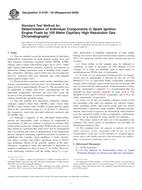Potrebujeme váš súhlas na využitie jednotlivých dát, aby sa vám okrem iného mohli ukazovať informácie týkajúce sa vašich záujmov. Súhlas udelíte kliknutím na tlačidlo „OK“.
ASTM D6729-04(2009)
Standard Test Method for Determination of Individual Components in Spark Ignition Engine Fuels by 100 Metre Capillary High Resolution Gas Chromatography
Automaticky preložený názov:
Štandardná skúšobná metóda pre stanovenie jednotlivých zložiek v Spark palív spaľovacím motorom o 100 Meter kapilárnej vysoké rozlíšenie plynovej chromatografie
NORMA vydaná dňa 15.4.2009
Informácie o norme:
Označenie normy: ASTM D6729-04(2009)
Poznámka: NEPLATNÁ
Dátum vydania normy: 15.4.2009
Kód tovaru: NS-36296
Počet strán: 51
Približná hmotnosť: 153 g (0.34 libier)
Krajina: Americká technická norma
Kategória: Technické normy ASTM
Anotácia textu normy ASTM D6729-04(2009) :
Keywords:
gas chromatograph, gasoline, individual hydrocarbon analysis, oxygenated fuels, spark-ignition engine fuels, Alkylates, Automotive engine fuels/oils, ETBE (ethyl tert-butyl ether), Ethanol, Gas chromatography (GC)--petroleum products, 100 Meter capillary high resolution gas chromatography, MTBE (methyl tert-butylether), Naphtha and naphtha derivatives, Oxygenated aromatics, TAME (tert-amyl methylether), ICS Number Code 75.160.20 (Liquid fuels)
Doplňujúce informácie
| Significance and Use | ||||||||||||||
|
Knowledge of the specified individual component composition (speciation) of gasoline fuels and blending stocks is useful for refinery quality control and product specification. Process control and product specification compliance for many individual hydrocarbons may be determined through the use of this test method. |
||||||||||||||
| 1. Scope | ||||||||||||||
|
1.1 This test method covers the determination of individual hydrocarbon components of spark-ignition engine fuels and their mixtures containing oxygenate blends (MTBE, ETBE, ethanol, and so forth) with boiling ranges up to 225°C. Other light liquid hydrocarbon mixtures typically encountered in petroleum refining operations, such as blending stocks (naphthas, reformates, alkylates, and so forth) may also be analyzed; however, statistical data was obtained only with blended spark-ignition engine fuels. 1.2 Based on the cooperative study results, individual component concentrations and precision are determined in the range of 0.01 to approximately 30 mass %. The procedure may be applicable to higher and lower concentrations for the individual components; however, the user must verify the accuracy if the procedure is used for components with concentrations outside the specified ranges. 1.3 The test method also determines methanol, ethanol, t-butanol, methyl t-butyl ether (MTBE), ethyl t-butyl ether (ETBE), t-amyl methyl ether (TAME) in spark ignition engine fuels in the concentration range of 1 to 30 mass %. However, the cooperative study data provided sufficient statistical data for MTBE only. 1.4 Although a majority of the individual hydrocarbons present are determined, some co-elution of compounds is encountered. If this test method is utilized to estimate bulk hydrocarbon group-type composition (PONA) the user of such data should be cautioned that some error will be encountered due to co-elution and a lack of identification of all components present. Samples containing significant amounts of olefinic or naphthenic (for example, virgin naphthas), or both, constituents above n-octane may reflect significant errors in PONA type groupings. Based on the gasoline samples in the interlaboratory cooperative study, this procedure is applicable to samples containing less than 25 mass % of olefins. However, some interfering coelution with the olefins above C7 is possible, particularly if blending components or their higher boiling cuts such as those derived from fluid catalytic cracking (FCC) are analyzed, and the total olefin content may not be accurate. 1.4.1 Total olefins in the samples may be obtained or confirmed, or both, if necessary, by Test Method D 1319 (volume %) or other test methods, such as those based on multidimensional PONA type of instruments. 1.5 If water is or is suspected of being present, its concentration may be determined, if desired, by the use of Test Method D 1744, or equivalent. Other compounds containing oxygen, sulfur, nitrogen, and so forth, may also be present, and may co-elute with the hydrocarbons. If determination of these specific compounds is required, it is recommended that test methods for these specific materials be used, such as Test Methods D 4815 and D 5599 for oxygenates, and D 5623 for sulfur compounds, or equivalent. 1.6 Annex A1 of this test method compares results of the test procedure with other test methods for selected components, including olefins, and several group types for several interlaboratory cooperative study samples. Although benzene, toluene, and several oxygenates are determined, when doubtful as to the analytical results of these components, confirmatory analyses can be obtained by using specific test methods. 1.7 The values stated in SI units are to be regarded as the standard. The values given in parentheses are provided for information purposes only. 1.8 This standard does not purport to address all of the safety concerns, if any, associated with its use. It is the responsibility of the user of this standard to establish appropriate safety and health practices and determine the applicability of regulatory limitations prior to use. |
||||||||||||||
| 2. Referenced Documents | ||||||||||||||
|
Odporúčame:
Aktualizácia technických noriem
Chcete mať istotu, že používate len platné technické normy?
Ponúkame Vám riešenie, ktoré Vám zaistí mesačný prehľad o aktuálnosti noriem, ktoré používate.
Chcete vedieť viac informácií ? Pozrite sa na túto stránku.




 Cookies
Cookies
